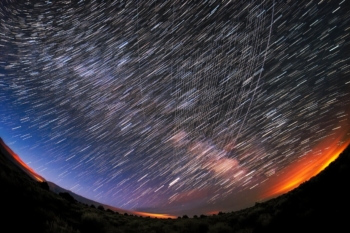Over the last number of years, our planet has become encircled by Starlink, OneWeb, and other “megaconstellation” satellites.
Yes, the emergence of those megaconstellations offers great benefit for humanity. But in a wait-a-minute pause, there are also substantial costs, including the imposition on humankind’s ongoing and growing thirst for astronomical peering into the surrounding universe.
That’s the view of David Koplow, the Scott K. Ginsburg Professor of Law at Georgetown University Law Center in Washington, D.C.

Starlink constellation pass overhead near Carson National Forest, New Mexico, photographed soon after launch.
SpaceX Starlink Satellites over Carson National Forest, New Mexico, photographed soon after launch.
Credit: Mike Lewinsky/Creative Commons Attribution 2.0
“We are just beginning to appreciate how bad the disruption can be for land-based and space-based telescopes, and as more and more satellite overflights occur, the problems will only intensify,” Koplow told Inside Outer Space.
Legal rights
Koplow’s concerns have been voiced in several scholarly works, the titles of which underscore his qualms, such as: “Large Constellations of Small Satellites: The Good, the Bad, the Ugly and the Illegal,” as well as “Blinded by the Light: Resolving the Conflict Between Satellite Megaconstellations and Astronomy.”

Starlink satellites visible in a mosaic of an astronomical image.
Courtesy of NSF’s
National Optical-Infrared Astronomy Research Laboratory/NSF/AURA/CTIO/DELVE)
“The world has mostly been assuming that the relevant international law basically allows the satellite companies to do whatever they want in space, while forcing the observatories to adapt as well as they can,” Koplow advised.
But in reality, Koplow continues, the legal regime is not so one-sided. “Astronomers also have legal rights to free use of space, and they need not stand by idly while their profession is damaged.”
Hair on fire
Koplow points out that in 2019 the world of optical and radio astronomy changed abruptly and massively when the first SpaceX batch of 60 Starlink satellites was lofted.
“Jolted by the sudden brightness of those spacecraft, and alarmed by the prospect of their legions of successors, observatories scrambled to respond,” Koplow observes.
They did so by studying and documenting the true dimensions of the problem, beginning to invent or conceptualize mitigation measures, and entering into discussions with SpaceX and other companies.
“Some astronomers see this as a true ‘hair on fire’ emergency, heralding irretrievable losses to space science; others present a more sanguine face, depicting this as yet another challenge to be surmounted in surveying a decreasingly pristine sky,” Koplow remarks.
Incipient clash
That said, the astronomical community has related that the time and the financial costs of conducting effective astronomy will rise considerably, Koplow says, “and that some important data will simply be irretrievable, with concomitant losses for science and the future exploration and use of space.”
In his “Blinded by the Light” treatise, Koplow describes the incipient clash between satellite megaconstellations and astronomy, assesses the relevant international and domestic legal authorities, and proposes compromise solutions to mitigate the damage.
“Overall, the thesis is that a better balance must be struck between these competing types of space activities,” Koplow adds, “without ceding to either a comprehensive right to proceed in disregard of the key functions of the other.”
Voluntary measures
Koplow acknowledges that some satellite companies have voluntarily invested considerable corporate talent and money in efforts to mitigate their interference with astronomy.
“But these voluntary measures are not adequate to solve the problem, they are not durable and reliable, and they have not been adopted by all the companies,” Koplow suggests.
“A stronger response is necessary,” Koplow concludes.
To gain access to “Blinded by the Light: Resolving the Conflict Between Satellite Megaconstellations and Astronomy” go to: https://papers.ssrn.com/sol3/papers.cfm?abstract_id=4346299
To review the paper “Three Things I Hate About Large Constellations of Small Satellites” go to: https://papers.ssrn.com/sol3/papers.cfm?abstract_id=4503593





A temporary problem until the telescopes are all moved into space.
I have no sympathy for the astronomers who seem to expect to halt progress while they pursue their hobby.
@Mike Borgelt We are all citizens of the earth. I mean that to illustrate that no one’s interests should interfere with another person’s interest. One group wants to peer at the sky at their leisure. Another group wants to make billions of dollars by putting things into the sky. Neither one has any greater right to do so than the other, so the one and only compromise, the one fair thing, is to agree with each other “You can do anything you please, as long as it doesn’t interfere with me.” What if the astronomy groups, no longer able to see the stars, turned to another hobby, namely inventing rockets that can track and destroy satellites? And were having a heck of a fun time doing it? You’d have a real problem with that, right? Then why do you not see a problem when it’s the other way around?
@Joe Everson Agree on the point that your freedom to swing your arms ends when you hit me. However, we live in a crowded world, so we have to be able to make the room for someone to swing their arms out of reasonableness.
I think the optimum solution would be for the effecting companies to sponsor foundationally/educationally owned space telescopes and loft a significant number up to high earth orbit, or Lagrange Points. Get enough advanced designed telescopes up in space, you could make a good case for the trade off of pristine earth observation loss in the name of progress like satellite based cell phone coverage.
My imagination runs away with some of the possibilities, such as coming up with space telescopes that can observe multiple targets at once. This could also turn into a national pride race, with entities like India, China, EU based countries all competing to equip their country’s astronomers with the best tools.
The biggest problem will be that the little guys, the amateur astronomers will end up bearing the brunt of the capacity loss in the technology change-up.